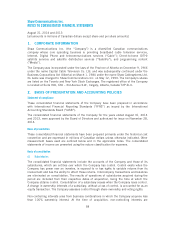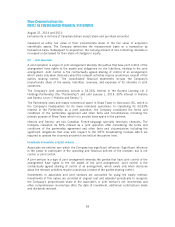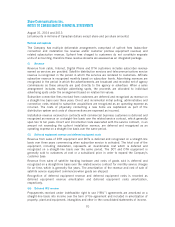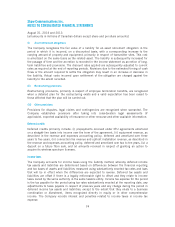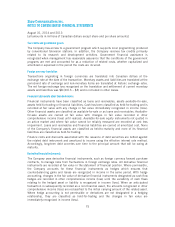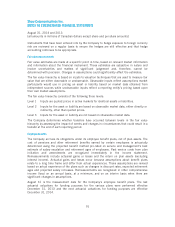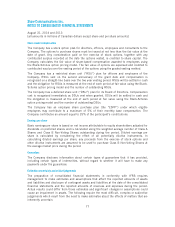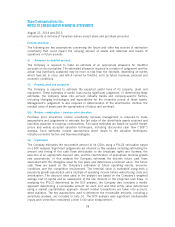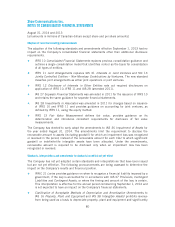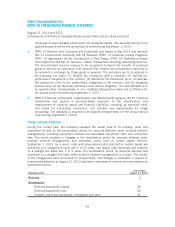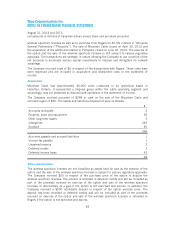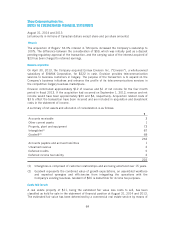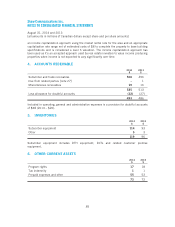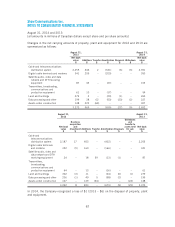Shaw 2014 Annual Report Download - page 81
Download and view the complete annual report
Please find page 81 of the 2014 Shaw annual report below. You can navigate through the pages in the report by either clicking on the pages listed below, or by using the keyword search tool below to find specific information within the annual report.Shaw Communications Inc.
NOTES TO CONSOLIDATED FINANCIAL STATEMENTS
August 31, 2014 and 2013
[all amounts in millions of Canadian dollars except share and per share amounts]
Share-based compensation
The Company has a stock option plan for directors, officers, employees and consultants to the
Company. The options to purchase shares must be issued at not less than the fair value at the
date of grant. Any consideration paid on the exercise of stock options, together with any
contributed surplus recorded at the date the options vested, is credited to share capital. The
Company calculates the fair value of share-based compensation awarded to employees using
the Black-Scholes option pricing model. The fair value of options are expensed and credited to
contributed surplus over the vesting period of the options using the graded vesting method.
The Company has a restricted share unit (“RSU”) plan for officers and employees of the
Company. RSUs vest on the second anniversary of the grant date and compensation is
recognized on a straight-line basis over the two year vesting period. RSUs will be settled in cash
and the obligation for RSUs is measured at the end of each period at fair value using the Black-
Scholes option pricing model and the number of outstanding RSUs.
The Company has a deferred share unit (“DSU”) plan for its Board of Directors. Compensation
cost is recognized immediately as DSUs vest when granted. DSUs will be settled in cash and
the obligation is measured at the end of each period at fair value using the Black-Scholes
option pricing model and the number of outstanding DSUs.
The Company has an employee share purchase plan (the “ESPP”) under which eligible
employees may contribute to a maximum of 5% of their monthly base compensation. The
Company contributes an amount equal to 25% of the participant’s contributions.
Earnings per share
Basic earnings per share is based on net income attributable to equity shareholders adjusted for
dividends on preferred shares and is calculated using the weighted average number of Class A
Shares and Class B Non-Voting Shares outstanding during the period. Diluted earnings per
share is calculated by considering the effect of all potentially dilutive instruments. In
calculating diluted earnings per share, any proceeds from the exercise of stock options and
other dilutive instruments are assumed to be used to purchase Class B Non-Voting Shares at
the average market price during the period.
Guarantees
The Company discloses information about certain types of guarantees that it has provided,
including certain types of indemnities, without regard to whether it will have to make any
payments under the guarantees.
Estimation uncertainty and critical judgements
The preparation of consolidated financial statements in conformity with IFRS requires
management to make estimates and assumptions that affect the reported amounts of assets
and liabilities and disclosure of contingent assets and liabilities at the date of the consolidated
financial statements and the reported amounts of revenues and expenses during the period.
Actual results could differ from those estimates and significant changes in assumptions could
cause an impairment in assets. The following require the most difficult, complex or subjective
judgements which result from the need to make estimates about the effects of matters that are
inherently uncertain.
77



